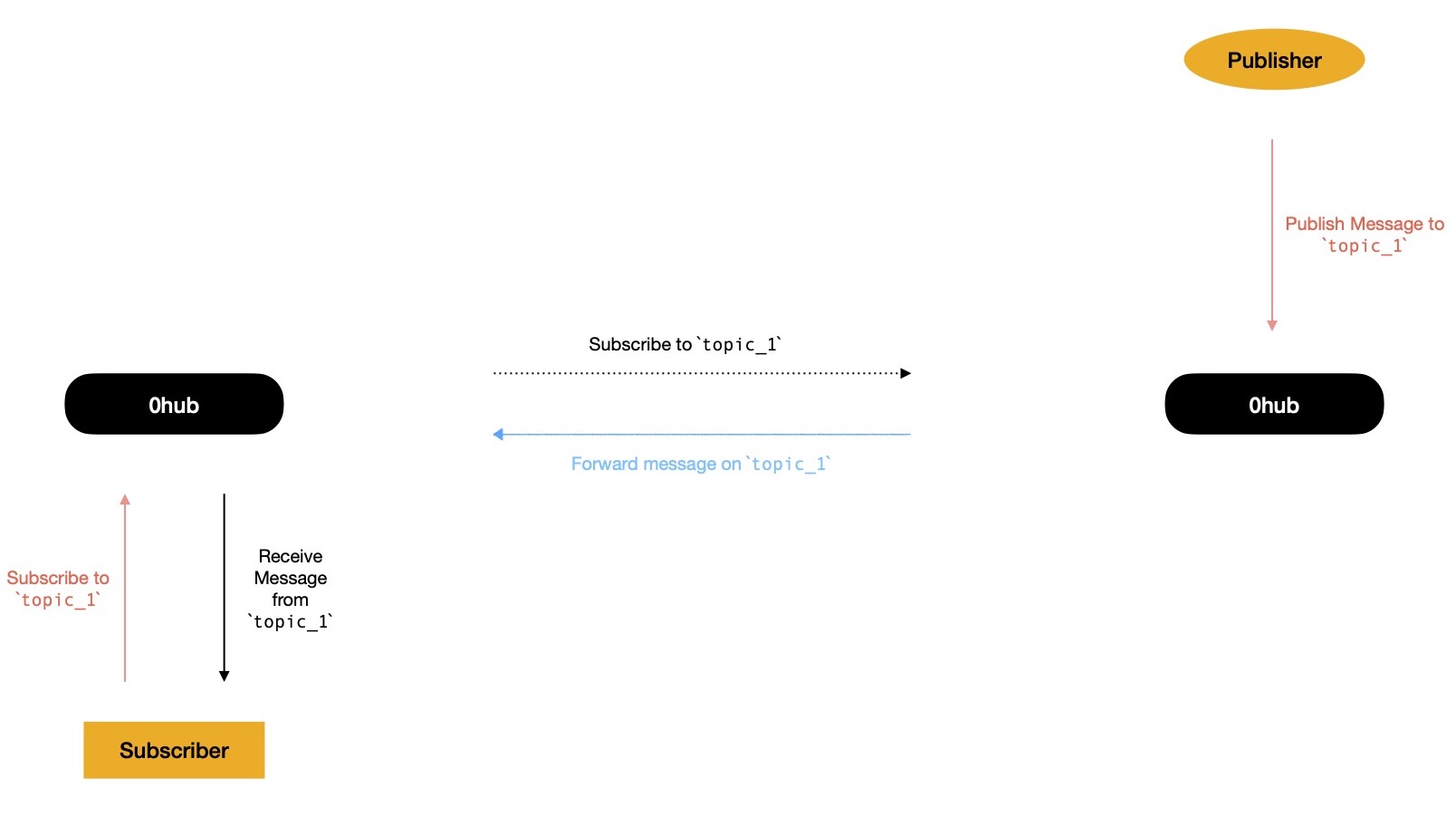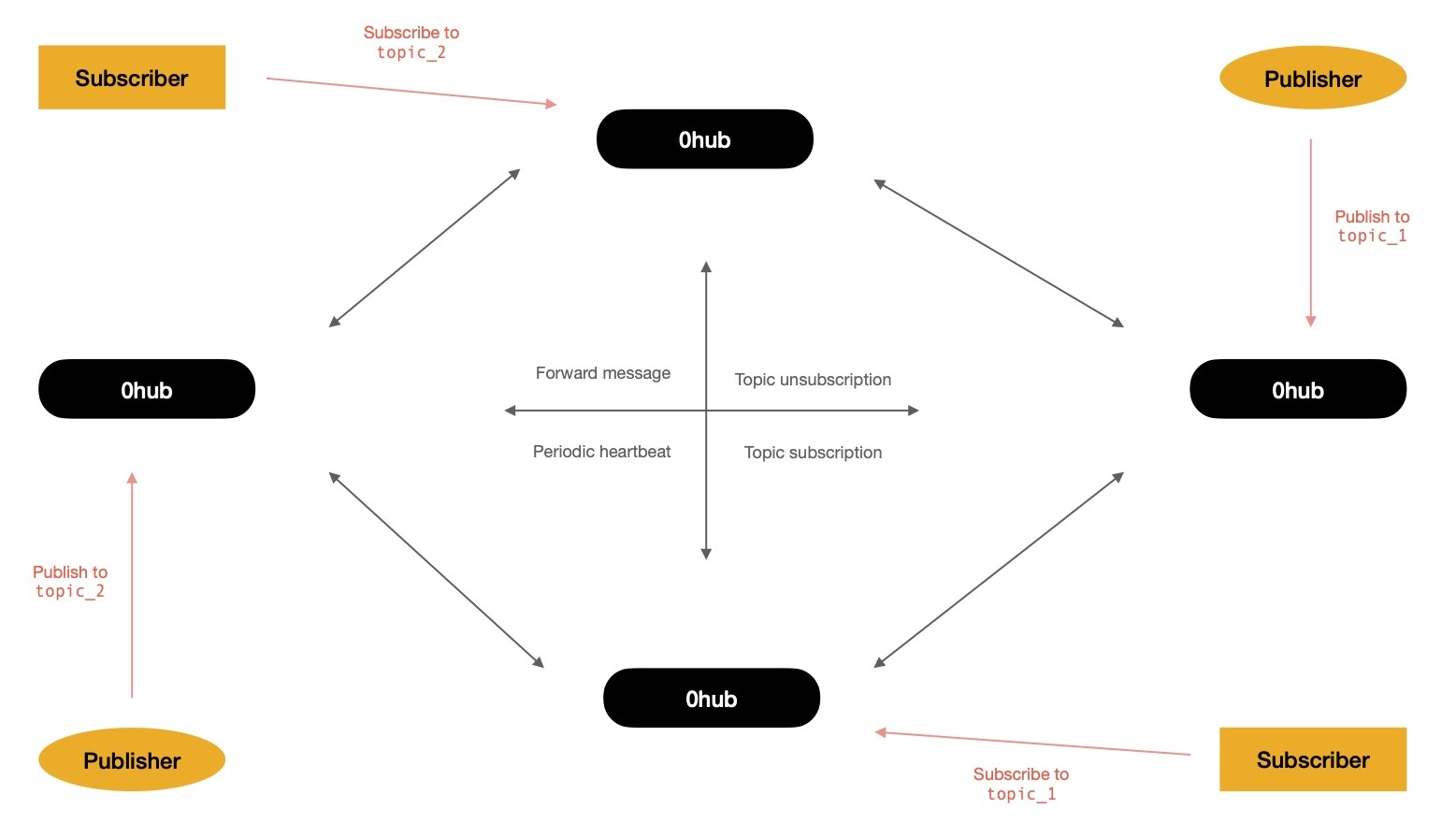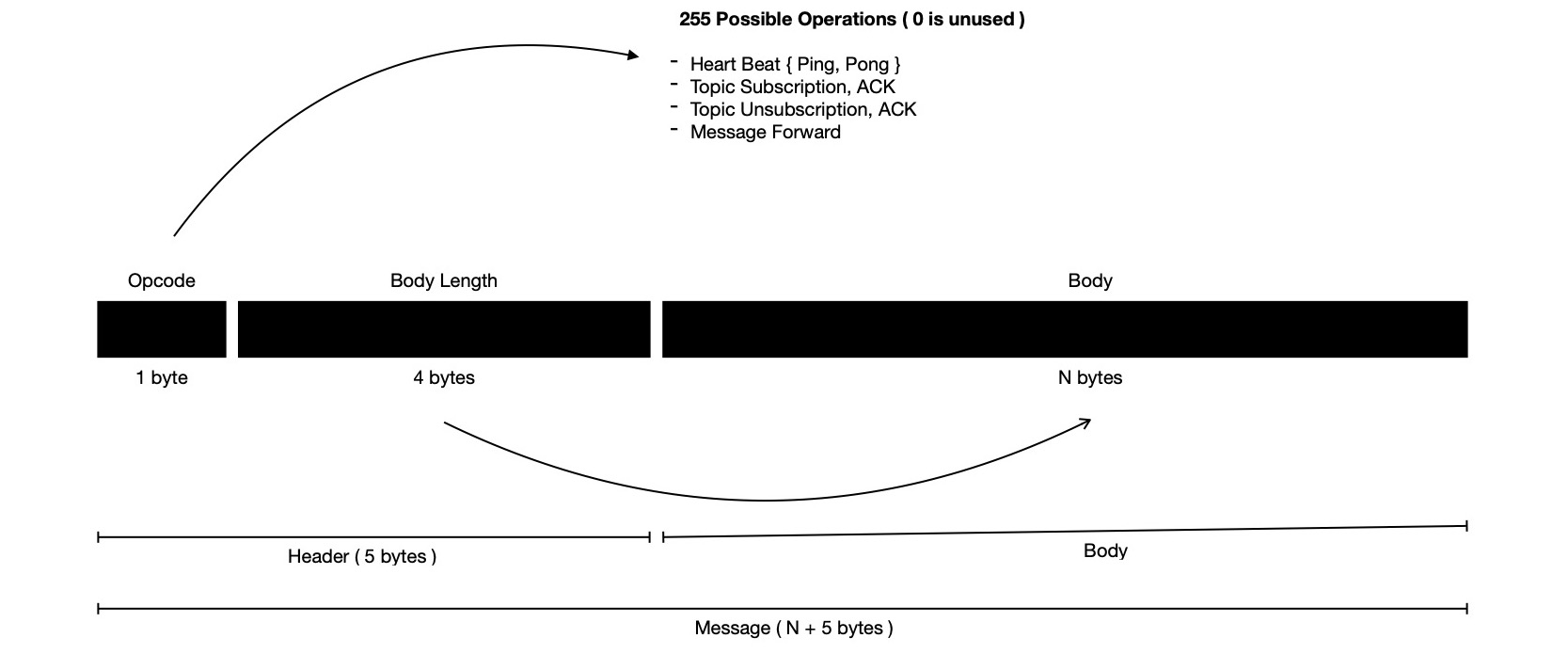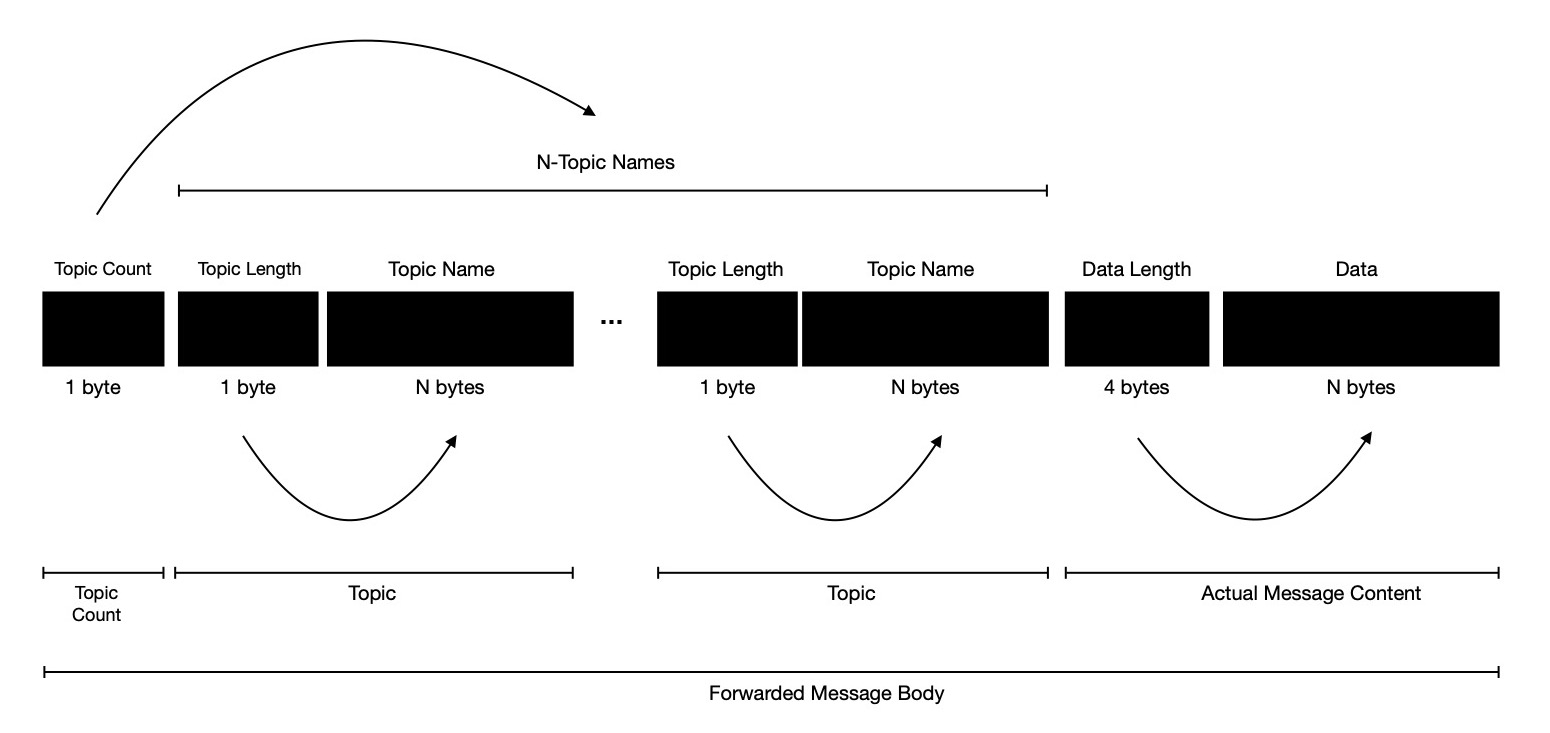Sometime ago I started working on pub0sub - Fast, Light-weight, Ordered
Pub/Sub
System --- built on top of async I/O, leveraging power of kernel event loop.
The main idea behind it was to write a software ( along with SDK ) which can be used for publishing
arbitrary length binary messages to N-many
topics; subscribing to N-many topics --- listening for messages published on each of them; and last
but not least
one powerful Pub/Sub Hub ( i.e. Router ) which will easily solve C10K by leveraging power of async
I/O.
The aforementioned problem statement is solved, which is why I decided to update problem statement.
Now it looks like pub0sub - Distributed, Fast, Light-weight, Ordered Pub/Sub
System --- solving
C1M easily while leveraging power of kernel event loop & p2p networking.
By making pub0sub distributed, I get to handle 1M concurrent
connection
where nodes form a mesh network for chatting about topic interest(s) & forward messages when need to
--- a collaborative effort among peers.
I choose to use libp2p for networking purpose, for being so modular
--- enabling easy horizontal
scalability, while taking care of stream multiplexing, security, peer-discovery etc.
Here I propose primary design of system !
Multiple pub0sub nodes can discover & connect to each other using DHT ( distributed hash table ) powered peer discovery mechanism, built right into libp2p and eventually form a mesh network. If network has N participant(s), each participant is going to maintain connection with other N-1 peer(s), where N > 0. These participants of p2p network are going to chat with each other over bi-directional stream. Things nodes need to talk about 👇
| Operation | Interpretation |
|---|---|
| Topic subscription | Letting peers know of interest in some topics |
| Topic subscription ACK | Peer saying it has noted down & will forward published messages if sees any |
| Topic unsubscription | Announcing not interested in topics anymore |
| Topic unsubscription ACK | Peer saying it has removed entry & will no more forward published messages |
| Published message forwarding | Passing published message to interested peer |
| Periodic heartbeat | Network health check |
As each of aforementioned operations require to pass different message formats, I'm going to define respective wire formats. But before I get into wire format, writing to/ reading from stream I'd like to spend some time in going through high level overview of network operation.

Say, two nodes form a cluster --- one node has a topic_1 subscriber connected to it while
other one has a publisher connected to it, willing to publish message on topic_1. After
first node finds out, it has one subscriber interested in messages from topic_1, it decides
to ask its peer 0hub node, if it sees any message targeted to
topic_1, it should inform requester. Publisher sends publish intent to network, which
triggers
event saying network has received some message on topic_1 for which first node has interested
subscriber.
Two nodes chat over p2p network, resulting into message forwarding, which enables first node
to deliver message published on topic_1 to its subscriber.
When noticed carefully, network follows certain protocols
- When subscriber shows interest in topic_1, 0hub broadcasts it to peers
- When publisher publishes message on topic_1, 0hub forwards message to all interested peers
Let's take another scenario.

Continuing previous scenario, after sometime subscriber doesn't anymore want to receive
messages published on topic_1, so it sends unsubscription intent to network. As a result
of it, respective 0hub node decides to broadcast same to network, because it found it doesn't have any other
subscribers who're interested in messages of topic_1. All peers who kept record of this node
being interested in topic_1, updates their respective interest table, ensuring when in future
it receives message published on topic_1, it won't forward to first peer.
This way of showing interest to topics when peers has some subscribers to feed or
announcing not interested anymore when all subscribers of certain topic unsubscribes --- allows
network to pass published messages only when needed, eventually consuming lower bandwidth. I call it Lazy
Pushing.
With more peers, network interaction may look like 👇 from high level, where 0hub nodes form p2p mesh network, other participants are mere clients.

Say, one subscriber shows interest in receiving messages from {topic_1, topic_2, topic_3} but the 0hub node it's connected to doesn't have any publisher of any of those topics. As soon as 0hub node learns it has subscriber to feed messages of {topic_1, topic_2, topic_3}, following protocol it announces that intent to other peers. Each of other peers record it & as soon as they receive any message published on any of these topics they forward those to respective peers.
I'll now spend some time in specifying wire-format of messages exchanged between peers.

Each message exchanged between peers over p2p layer, needs to have two parts
- Header ( 5 bytes )
- Body ( N bytes )
Just by reading header part receiver must be able to understand two things
- What kind of operation is it ?
- How many more bytes to read from stream for consuming message body ?
First question can be answered by checking very first byte of message. Each operation is denoted by unique opcode. There're 255 possible opcodes, though only 6 of them are in use as of now.
| Interpretation | Opcode |
|---|---|
| Heartbeat | 1 |
| Topic subscription | 2 |
| Topic subscription ACK | 3 |
| Topic unsubscription | 4 |
| Topic unsubscription ACK | 5 |
| Message Forward | 6 |
By reading next 4 bytes from header, receiver understands how many more bytes it should read from stream
so that it can successfully deserialise message, depending upon opcode. Each opcode denotes
different
message wire-format, resulting into invocation of different deserialisation logic upon reception.
Above is a high level wire-format, which is applicable for each of messages. But I'd like
to define how BODY of message is serialised/ deserialised for different opcodes. Starting
with
how it looks like when announcing interest in listening to some topics.

Note, above image is nothing but magnification of message BODY when opcode ∈ {2, 4}.
Requirement
is peer needs to announce it wants to receive all messages published on topics, because it has
some subscribers interested in those. Receiver side when reading from stream, knows how many
bytes it needs to read from stream for completely consuming BODY.
It starts by reading first 1-byte, where it has instruction encoded how many next bytes it should
read for making one meaningful topic name. Now it has either consumed all bytes of BODY
or some of them are left. If left, it'll again consume 1-byte, carrying instruction for it for
figuring out what's next topic name. This way, it'll keep reading until it has exhausted all bytes
of BODY. By the end it must have successfully constructed structured object in respective
environment, containing topics some peer want to get notified of.
Similar wire-format is followed for serialising BODY when announcing lack of interest in some
topics.
Both of aforementioned opcodes, expect to hear back with ACK messages i.e. opcode ∈ {3, 5}, where
BODY can be encoded by putting binary value denoting success/ failure. These are expected to
be received with in a stipulated time window after interest ( opcode 2 ) / lack of interest ( opcode
4 ) message is sent to peer. If not
received, for opcode 2, it'll be resent upto N-times. If still not received, it results into
connection termination
with peer for not following protocol.
But if peer is waiting for ACK of message with opcode 4, it doesn't resend, because of being low
priority. Of course
it might result into network wasting some bandwidth for passing some published message which could have been
avoided. If any forwarded message
from any topic to which peer is not interested in, is received even after lack of interest message
was broadcast ( opcode 4 )
it can be ignored by receiver. Receiving peer also sends another message to respective peer with
opcode 4, stating it's
not interested in these topics --- just like repeating self. This is done so that next time network can save some bandwidth.
Finally I'll cover how to serialise/ deserialise forwarded message to/ from stream.

Start by reading first byte of BODY, which encodes how many topics this message is being
targeted to.
A message can be targeted to 255 topics at max. Receiver knows how many topics it should be reading
from stream.
So it starts by reading next 1 byte, encoding first topic's byte length. It knows how many next
bytes to be read
for figuring out first topic name. It has just read one topic name. Similarly it'll continue reading
more topic names
until all are read off. After N topic names are read, it'll read 4 bytes, encoding how many next
bytes it needs to
read for extracting out actual message content.
Eventually it'll reach end, constructing structured data by consuming stream. This is how forwarded
messages
are recovered from stream by some peer who showed interest in getting notified when some message is
published
on topics of interest. After getting structured data, receipient 0hub
node can
send message to subscribers connected to it directly, interested in any of topics this message is
published on.
Reader may notice, a slight difference in encoding variable number topic list, between
previous two diagrams.
When encoding to be forwarded message ( opcode 6 ), peer encodes topic count in first 1-byte of
BODY part of message.
This is required, otherwise during deserialisation receiver won't be able to understand where in
stream it should stop
reading topic names & start reading 4-byte lengthy actual message content's length field.
But same is not required for message sent with opcode ∈ {2, 4}, because there's nothing more to read
after topic name list
and receiver already knows length of BODY part of message, so it knows how long to read from
stream.
Let's go through one example
Say 0hub peer want to announce its interest in messages published on
topic_1, topic_2. Serialised message for this operation looks like
| Message Part | Field Name | Field Byte Length | Field Value |
|---|---|---|---|
| Header | Opcode | 1 | 2 |
| Body Length | 4 | 16 | |
| Body | Topic-1 Length | 1 | 7 |
| Topic-1 Name | 7 | topic_1 | |
| Topic-2 Length | 1 | 7 | |
| Topic-2 Name | 7 | topic_2 |
21 bytes of data to be sent to each peer, resulting into (N-1) * 21 bytes of data
broadcast in total, where N > 0 & N is #-of participants in mesh network.
Similarly by following aforementioned example, message of lack of interest to topics ( opcode 4 )
can be published on network.
Finally I'll go through one last example showing serialisation of to be forwarded message i.e.
opcode 6.
Assuming this message is published on topic_1, topic_2 & content of message is
hello.
| Message Part | Field Name | Field Byte Length | Field Value |
|---|---|---|---|
| Header | Opcode | 1 | 6 |
| Body Length | 4 | 26 | |
| Body | Topic Count | 1 | 2 |
| Topic-1 Length | 1 | 7 | |
| Topic-1 Name | 7 | topic_1 | |
| Topic-2 Length | 1 | 7 | |
| Topic-2 Name | 7 | topic_2 | |
| Data Length | 4 | 5 | |
| Data | 5 | hello |
This results into sending 31 bytes of data to each of those peers who showed interest to topic_1, topic_2. Not to all N-1 remaining participants of mesh network --- Lazy Pushing at work.
Peers need to periodically send heartbeat messages for checking health of long-lived network
connections
to other peers. Opcode 1 is reserved for this purpose, where BODY of message ∈ {ping, pong}.
If reader has covered whole proposal, they probably understand this is by no means a final version
of design.
Improvements like not forming strongly connected mesh helps in reducing huge bandwidth cost --- can
be taken into consideration to further
enhance protocol. Message authentication can be added so that peers only accept connection request
from other peers
who are trusted, when such setup is desired.
Existing pub0sub implementation is here.
Your feedback will be invaluable. Have a great time !